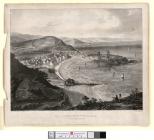Aberystwyth Lifeboat
Items in this story:
RNLI Aberystwyth
The RNLI Lifeboat station in Aberystwyth celebrates its 150th anniversary in 2011, but the town has had a lifeboat since 1843. The lifeboat station was under the control of the Harbour Master to begin with.
The RNLI arrived in Aberystwyth in 1861, with the lifeboat 'Evelyn Wood', which cost £170. The boat was presented to the station in November 1861, and worked until 1876. During that period it was called out 13 times and saved 16 lives.
The lifeboat house at that time was situated on Victoria Terrace, near the Glengower Hotel today. The house was built for £125 5s 6d, and the builder was paid £5 extra for clearing rubble which was already on the site. It took two months to build.
A new home for the lifeboat
The boat 'Evelyn Wood' carried a crew of 13 men, and was driven by ten oars, so a large number of people were needed to launch it. It was launched from the beach in the early days, and there were problems as the beach changed every day with the tides, so a slipway had to be built from the promenade to the water. The present jetty is on the site of the old slipway.
A new hut to hold a bigger lifeboat was built in 1885 on Queens Road. The RNLI used pull and row lifeboats until November 1932, when a motor boat arrived for the first time. The name of the last Aberystwyth pull and row boat was the 'John & Naomi Beattie'. In the RNLI's first 70 years in Aberystwyth, 52 lives were saved in 38 calls. When the first motor boat arrived in Aberystwyth, the Helmsman, David Williams, decided to retire after 42.5 years. He still holds the record for serving longest as Helmsman!
The new motor boat 'Frederick Angus' was 35 feet and 6 inches long, and cost £3,326 to build in 1932. It saved 25 lives during its 17 years of service in Aberystwyth. It was kept busy during World War II searching for planes forced to land in the sea. The 'Frederick Angus' was damaged in rough seas in 1949, and so was replaced by 'Lady Harrison', a boat from the Navy. It served for a period of two years.
Inshore Lifeboat - (ILB)
During the summer of 1951 the 'Aguilla Wren' came to Aberystwyth, a 35 feet 6 inches Liverpool Class boat. It cost £14,142 to build. It had a double diesel engine, and could reach a speed of 8 knots. It had a medium wave radio, and this was the first motor only boat to work in Aberystwyth. The 'Aguilla Wren' served until October 1964, and saved 14 lives during that period.
In 1963 the RNLI decided to introduce Inshore Life Boats (ILBs) as an experiment, and Aberystwyth was the first station in Britain to get one. It was a hot topic at the time; many people that a dinghy with an outboard motor would be ineffective as a lifeboat. They were proved wrong, and a year later the RNLI removed the 'Aguilla Wren' from the station and ILBs have been used since then.
Between 1963 and 1983, Aberystwyth station had three Class D Inshore Life Boats, with 40 hp single motors and VHF radio. They had a crew of two or three and could reach a speed of 20 knots. They were easy and quick to launch as they did not need a large crew.
The present station
The original ILBs were stored in an old warehouse at the side of the quay and would be launched down the slipway to the harbour. The warehouse was extended in 1983 in order to keep a Class C ILB which was bigger than the previous ones. This had a 40 horsepower double motor and could reach a speed of 27 knots. It carried a crew of three or four, but as it weighed nearly three quarters of a ton, it needed a tractor to launch and retrieve it. The tractor was especially designed for the RNLI and can work in water four feet deep!
Following the 1990 coastal review, the RNLI decided to upgrade Aberystwyth's facilities. A new shed was built which was big enough to keep a new Atlantic 21 ILB at the bottom of the quay. This boat could right itself if it capsized, and it arrived in Aberystwyth in June 1993. The boat represented the RNLI's commitment to Aberystwyth.
It ws replaced by the Atlantic 75 ILB 'Enid Mary' a year later. The 'Enid Mary' was launched twenty times during 1994, saving three lives! In 2011, a century and a half since the RNLI came to the town, the 'Enid Mary' is still here and going strong.
Do you have any photographs to go with this story? Please upload them to the People's Collection Wales website.



